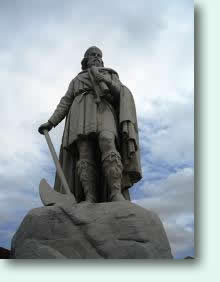Errata in Understanding English Grammar: A Linguistic Introduction
 Statue of King Alfred the Great in Wantage, Oxfordshire, England (photo by Philip Jelley) |
Chapter 1, p. 35. Exercise 2: Modern English translation f. Replace "old" with "good". (The translation should be "The foolish person sees the good person.")
Last line of examples should be:
brimliðend --none--
("brimliðend" is one word and "--none--" should be below "Related modern word")
Chapter 2, pp. 45-46, examples 6-10. In the Roman alphabetic transliteration of the Japanese examples, "ga" should be replaced by "wa". The Japanese is correct -- the transliteration is incorrect.
Chapter 7, p. 185, examples d. and e. of exercise 3. The underlining should extend to the end of each sentence:
d. I've been worrying about the water pressure for weeks.
e. I've been worrying about the water pressure in the kitchen,
Chapter 8, p. 190. First paragraph following example 13: The last sentence should read "In other words, the tree in (4b) above is more consistent with the syntactic facts of English than the tree in (4c)."
The first sentence of the following paragraph should read "Now let’s consider how to label the tree in (4b)."
Please send me email if you find any additional errors.
Note: As mentioned in the Introduction, many of the examples in Understanding English Grammar are verbatim quotes from the British National Corpus, the Corpus of Contemporary American English or from the Internet Movie Data Base (www.imdb.com). Since these are direct quotes, sometimes grammatical, spelling or punctuation "errors" may occur. These are not errata in the text; rather they simply reflect how native speakers speak and write their individual varieties of English. I don't think any such departures from Contemporary Standard English affect the main point being made in the examples in question. I hope this is not too confusing to readers.
